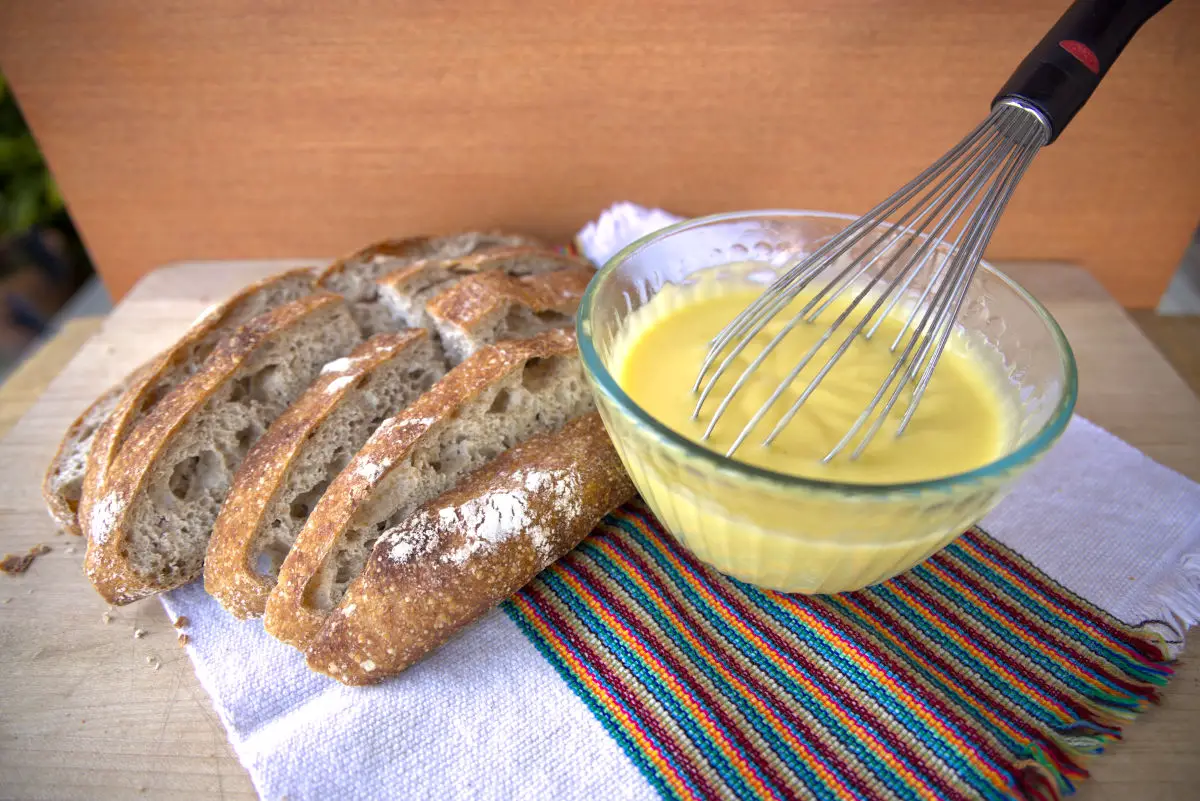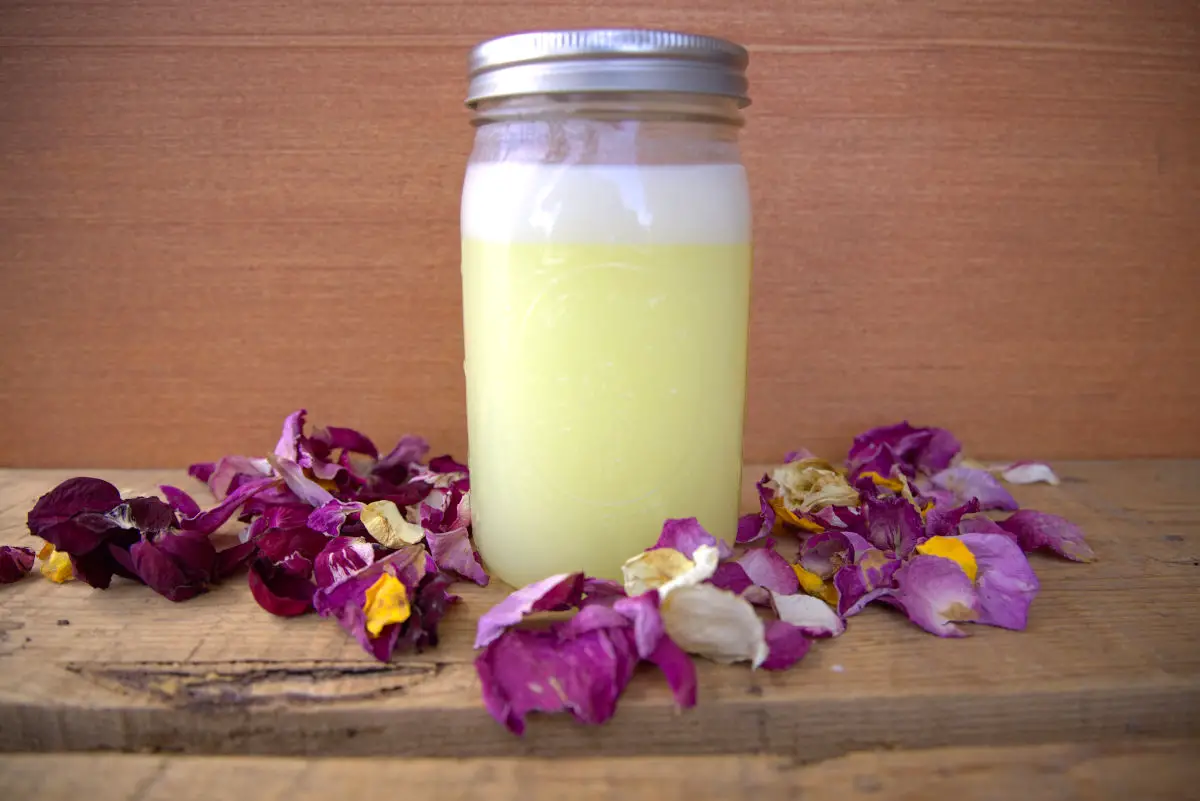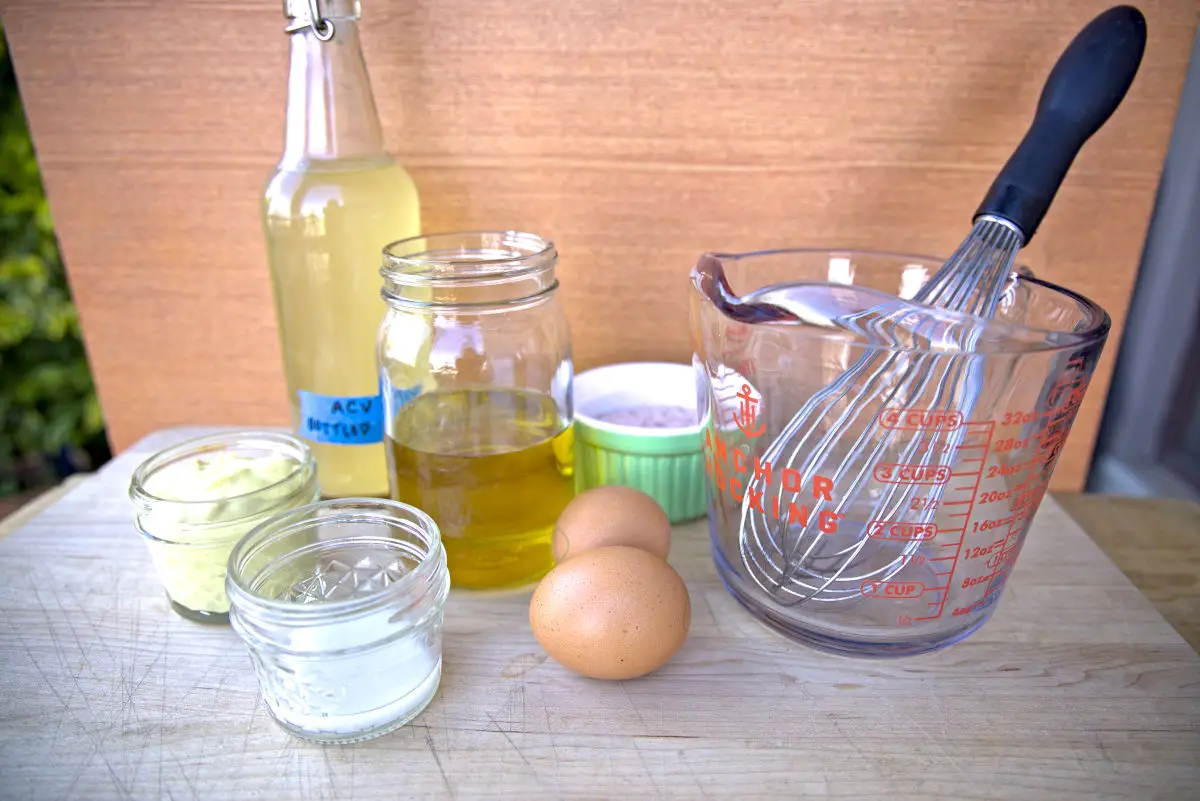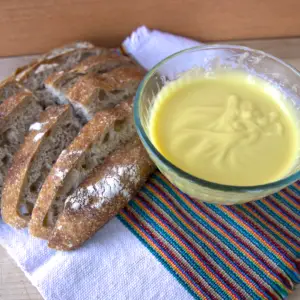If you’re like us, a good condiment can be life-changing. Ok, that might be a SLIGHT exaggeration, but only slight. It might seem basic or even trivial, but learning how to make mayonnaise from scratch beats buying any store-bought brand…in quality and flavor. Homemade mayonnaise is so quick (hands-on time is only 10 minutes) and simple that this mayonnaise recipe will surely make your permanent from-scratch cooking list.

Homemade Mayonnaise
Even if you’ve made your own mayonnaise before, you might not know the “secret” ingredient for how to make mayonnaise that lasts longer. Adding whey to your mayonnaise not only increases its refrigeration lifespan but the fermentation adds beneficial probiotics to what some might consider an unhealthy food. When it comes to homemade mayo, though, even without the whey it’s packed with simple ingredients and healthy fats! Especially in a rush, you can make this mayonnaise recipe without the extra fermentation step.
Interested in learning more about fermentation? Check out this blog post.
Why Make Your Own Mayonnaise?
A mayonnaise free from preservatives! I mean, it’s the simple things. You also get to choose a higher quality oil than most of your store-bought options will contain.
Believe it or not, mayonnaise is made with just a few simple ingredients that you probably already have around your place if you cook. No need to run out to the grocery store when you can whip up your own!
You can make variations to your condiment so that it’s exactly to your liking.
Like a more vinegary/tart mayonnaise? Add extra vinegar or lemon juice.
A fan of garlic-flavored mayonnaise? Add minced garlic.
You get the idea…
Methods
Whisk: This is the old-school method, and I have to admit the one I use most regularly. There’s just something about that brisk, impassioned whisking motion that’s satisfying. Add all ingredients except the oil into a bowl. Whisk to combine. Gently drizzle in the oil while continuously whisking until it is emulsified and thick.
Blender: A blender is my second choice, and it makes for a simpler job. Just add everything except the oil into the blender, pulse to combine, and then slowly drizzle in the oil while it’s running.
Food processor: This is the same process as a blender.
Hand-mixer: Add all ingredients except the oil to a bowl. Mix to combine. Gently drizzle oil in while mixing until it is your desired consistency.
Immersion blender: Place all ingredients, with the oil being last, in a large glass jar (a quart is perfect). Insert your blender into the bottom of the jar, turn your blender on, and then take about 20 seconds to slowly pull the blender upwards to the top of the jar.

How Can You Make Mayonnaise Last Longer?
One of my frustrations with making homemade mayonnaise used to be that it only lasts about a week or so in the fridge. That frustration faded into the distance when I found out about just one “secret” ingredient addition…..whey!
Adding whey to your mayonnaise (and letting it ferment on the counter for about 8 hours) will keep your mayonnaise fresh for over a month in the fridge!
Whey and Lacto-fermentation
Let’s talk about the magic that is whey. Whey is often a byproduct when making cheese or yogurt. It is one of the two main proteins in milk. If you make your own yogurt, you often strain it of whey to produce a thicker (greek-style) product. When you buy yogurt, it is the cloudy, yellowish liquid that settles on top.

So, either collect some of the whey from your own yogurt-making or pour off the liquid from the top of a container of yogurt! Make sure the yogurt is unflavored.
The scientific term for what happens when we add whey to our mayonnaise and allow it to sit on the counter is lacto-fermentation. The eight hours on the counter allow the mayonnaise to ferment as the enzymes of the whey are activated to better preserve our condiment.
If you are an experienced fermenter, feel free to try replacing the whey with other probiotic liquids or brines you have around.
Variations
The four must-use ingredients for making mayonnaise are oil, vinegar, egg yolks, and salt. This might not make for peak flavor, but it is the base. Adding mustard in my opinion is non-negotiable too. There are variations in which sugar or white pepper is added to perk up the mayonnaise.

More flavor-specific additions to your mayonnaise can include minced garlic, fresh or dried herbs such as basil or thyme, and red pepper flakes or cayenne pepper.
And of course, for this recipe we incorporate whey to keep our mayonnaise fresh for longer (and those added fermented probiotics are nothing to complain about).
FAQs (Frequently Asked Questions)
The yellow hue is completely natural and comes from the egg yolks and your choice of mustard. Using only egg yolks instead of the whole egg or choosing a yellow mustard will affect the color. That’s just some all-natural goodness you’re looking at.
1. Make sure you have blended everything except the oil before slowly adding the oil. Both are important to the consistency of your mayonnaise. An incredibly slow drizzle of the oil is the key to making a nice, thick mayonnaise.
2. Sometimes the ol’ hand and whisk just doesn’t do the trick. If you’ve whisked your heart out and still aren’t achieving that thick texture, you might have to place it in a blender to help in the emulsification.
If you look at the recipe, you’ll notice that the majority of the mayonnaise you’re making is oil! Using extra virgin olive oil or another potent oil (whose flavor you don’t particularly enjoy) will affect the final flavor. My oil of choice is avocado, and if you’re using olive oil I would try a regular or light one. I steer clear of lower-quality, industrial seed oils such as canola, grapeseed, or peanut.
Apparently, this happens! If your mayonnaise looks more like a wobbly block of Jell-O, just add ½ TBSP of hot water and whisk to combine. Do this until you’ve reached your desired consistency.
It’s called a “break” when there is an error in the emulsification of the mayonnaise and it separates. If you can see your oil, this is what has happened. It actually might have been caused by an over-beating of your mayonnaise. Have no fear. Beat an egg yolk with ½ tsp of mustard in a separate bowl and then slowly drizzle it into your bowl of mayonnaise while whisking. You could alternatively whisk in 1 TBSP of boiling water while vigorously whisking, but that might thin out your mayonnaise.

More From Scratch Condiments
From scratch condiments are great for cutting out artificial preservatives and eating meals with fresher ingredients.

Homemade Mayonnaise
Equipment
- Whisk, blender, immersion blender, food processor, or hand mixer.
Ingredients
- 2 egg yolks or 1 whole egg
- 1 tsp mustard dijon or yellow
- ½ tsp salt
- 2 tsp vinegar distilled white, apple cider, or just lemon juice
- 1 tbsp whey from homemade or store-bought plain yogurt
- 1½ c oil avocado or light olive oil
Instructions
- Place all ingredients except for the oil in a medium bowl or measuring glass. Whisk to combine.
- Slowly drizzle the oil into the mixture while constantly & briskly whisking. Mix until emulsified and to your desired thickness.
- Place mayonnaiese in the container you wish to store it in, cover it, and let it sit on the counter for 8 hours.
- Transfer to your fridge. It's ready to enjoy!
Notes
- If you are adding any additional add-ins you can mix them in after your mayonnaise has emulsified and before you let it sit. See the blog post for ideas on variations.
- When properly fermented this mayonnaise will last over a month in your fridge! If you have omitted the whey and fermentation period, expect it to last between 1-2 weeks.
- For troubleshooting your mayonnaise, see the end of the blog post.


Leave a Reply